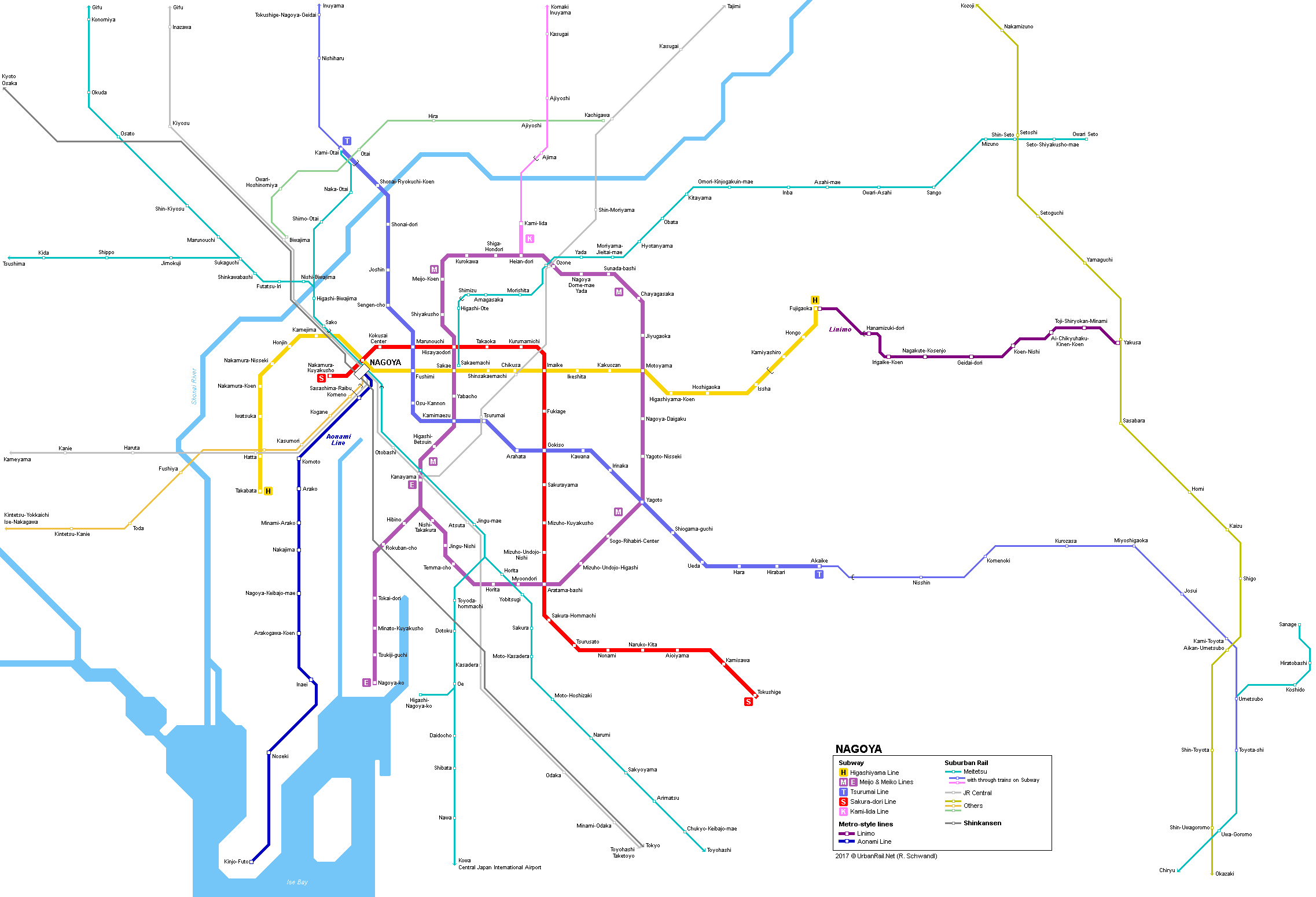
|
[ UrbanRail.Net ] [ Europe ] [ Americas ] [ Asia ] [ Africa ] [ Oceania ] [ News ] [ Books ] [ Links ] |
|
NAGOYA
|
| Japan |

|
System
|
|
Nagoya has a population of 2.3 million (some 8 million in the larger metropolitan area) and built Japan's third subway system (1957) following Tokyo and Osaka. Today there are five lines, of which two, the Meijo and the No.4 Line, are operated jointly. The total length of the network is 93.3 km with 100 stations (average distance is 968 m). With 1.3 million daily passengers, the Nagoya Subway has only a share of little more than 10% of all trips done within the city, traffic is still dominated by the use of private vehicles. Most subway cars and major stations have been equipped with air-conditioning, the newer Sakura-dori Line also offers access via elevators. The metro is operated by the City of Nagoya Transportation Bureau.
|
| :: Subway Lines |
| Higashiyama Line (H) |
|
(Line 1) - 20.6 km, 22 stations (H01-H22), partly elevated at eastern end, 37 minutes travel time, 2-4 min. headway, 6-car-trains, 1435 mm gauge, 3rd-rail power supply, ATS.
|
|
|
| Meijo and Meiko Lines (M & E) |
|
(Lines 2 & 4) - 33.4 km, 34 stations, completely underground, 2.5-8 min. headway, 6-car-trains, 1435 mm gauge, 3rd rail, ATC. Until 2004, the Kanayama - Aratama-bashi stretch was known as Line No. 4. Upon completion on 6 Oct. 2004, the circle line became known as the Meijo ("Nagoya Castle") Line (M01-M28) and the spur running to the port is now the Meiko ("Nagoya Port") Line (E01-E07). Trains from the Meiko Line usually run through to Ozone on the Meijo Line.
|
|
|
| Tsurumai Line (T) |
|
(Line 3) - 20.4 km, 20 stations, short surface section at western end, 35 min. travel time, 4-6 min. headway, 6-car-trains, 1067 mm gauge, overhead line, ATC. Through service (60 km) in both directions on Meitetsu Toyota Line (off-peak every other train) and Inuyama Line (1-2 trains per hour).
|
|
|
| Sakura-dori Line (S) |
|
(Line 6) - 19.1 km, 21 stations, completely underground, 4-6 min. headway, 5-car-trains, 1067 mm gauge, overhead line, ATC.
|
|
|
| Kami-Iida Line (K) |
|
(Line 7) - 0.8 km, 2 stations: actually an underground extension of Meitetsu's Komaki Line (21 km), with all trains running through on the suburban route; off-peak every 15 min, peak every 7.5-10 min.
|
|
|
|
|
|
Subway
History
|
|
15/11/1957
- Nagoya - Sakae (2.4 km)
|
| :: Other Metro-style Lines |
| Aonami Line (AN) |
|
15.2 km mostly elevated urban railway line within the City of Nagoya, which is also called the Nishi-Nagoyako Line (West Nagoya Port Line) operated by the Nagoya Seaside Rapid Railway. Passenger service on this former freight line began on 6 Oct 2004. Starts from a dedicated platform at Nagoya station, located between Shinkansen and conventional JR tracks.
|
|
|
| Linimo (L) |
|
For the Expo 2005, a new line, the 8.9 km maglev Linimo (Tobu Kyuryo Line) was built from Fujigaoka (terminus of Higashiyama Line) to Yagusa Station on the Aichi Loop line. "Linimo" stands for "linear motors". The western terminus lies underground next to the elevated terminus of the Subway's Higashiyama Line. [Website]
|
|
|
|
|
|
Book |
|
NEW: METROS & TRAMS in JAPAN Vol. 2: Nord- und Zentraljapan | North & Central Japan Metros in Sapporo, Sendai and Nagoya as well as trams in Hakodate, Toyama, Fukui, Takaoka, Toyohashi, Kochi, Matsuyama plus various other urban rail systems in North & Central Japan 144 pages;
Network maps; ca. 300 colour photos The second volume of our trilogy about urban rail systems in Japan covers all the systems in North and Central Japan, from the metros in Sapporo, Sendai and Nagoya to the numerous tram networks and various private suburban railways. This volume also includes all the cities with urban rail systems on the islands of Shikoku and Okinawa. As usual, the book is illustrated with a large number of recent colour photos and detailed network maps. |
|
Photos
|
|
Links
|
|
City of Nagoya Transportation Bureau [English] Nagoya Subway at Wikipedia Aonami Line (Official Site) |
|
Photos
|
|
|
2011 © UrbanRail.Net by Robert Schwandl.